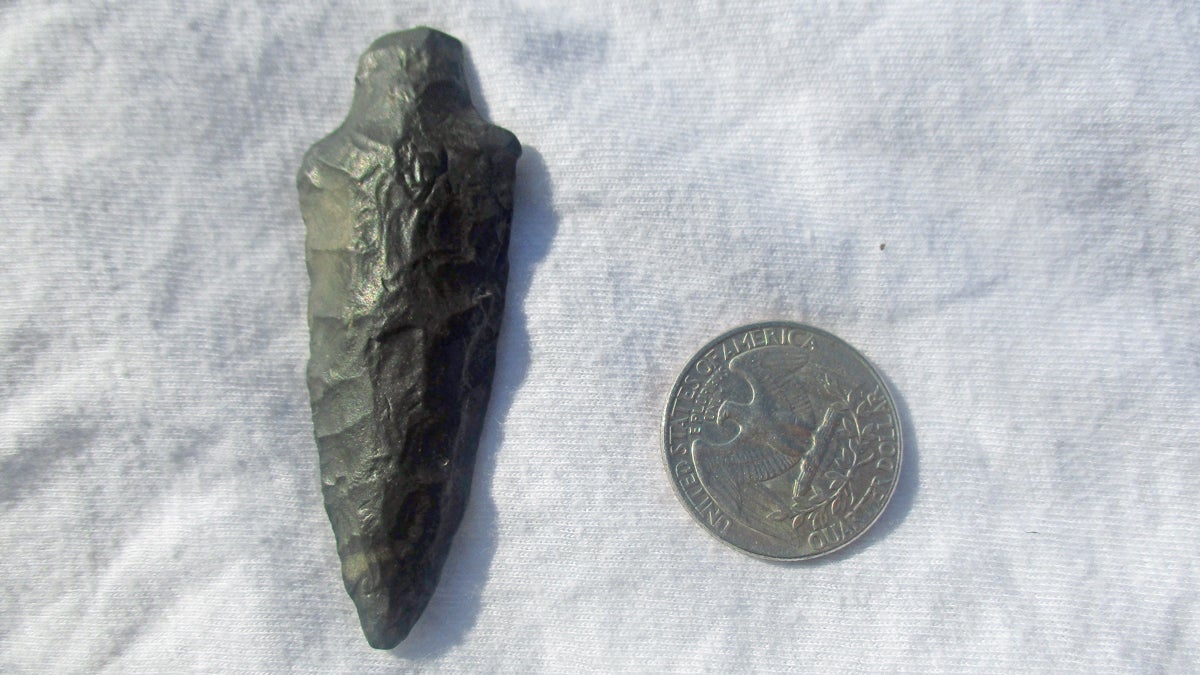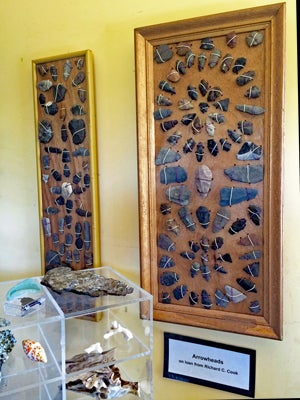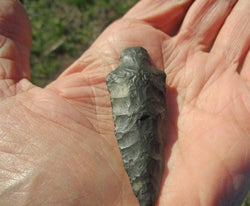Cape May becoming a popular spot to find Native American artifacts

This arrowhead was found in November at the bay at Cape May Point
When he was nine years old, Alexander Smida found a Native American spearhead while playing near the water on Sunset Beach in Cape May, New Jersey. He put it in the pocket of his denim cutoffs, hoping it wouldn’t get damaged by all of the shells and other treasures there, and brought it to a bunch of fishermen on the nearby jetty. They were not enthused. “We see this kind of thing here all the time,” they told him.
Fifty-three years later, prehistoric artifacts are still consistently turning up along Cape May’s bayside beaches, but one thing is different. The level of enthusiasm – yes, even amongst salty fishermen — is at an all-time high.
Operators of the popular Sunset Beach gift shop estimate approximately 1,000 to 1,500 people comb this particular beach specifically for Native American artifacts every summer. Some collectors report a competitive edge among fellow hunters, who make sure to stay one step ahead during long walks of the shoreline. And stories of local legends, like the late Gladys Bowers of Cape May Point, are swapped in hushed tones: I heard she found 2,000 arrowheads, you’ll hear at the gift shop counter. I heard it was closer to 5,000.
After his first find, Smida caught the collector’s bug. Today he keeps a cigar box full of his discoveries, most of them projectile points around 2,000 years old. He’s one of many that will tell you – in Cape May, it’s worth your while to look down.
Why Cape May Prehistoric artifacts turn up throughout the state of New Jersey. In 2010, a ten-year-old boy in the town of Neptune discovered a 10,000-year-old arrow point likely used to spear mastodon. That same year, archeologists turned up over 100 artifacts in Pilesgrove. The free library in Bridgeton is home to the Woodruff Museum of Indian Artifacts, which displays more than 30,000 relics from the area. But Cape May is arguably the most conducive town in the state for the hobby hunter.
Prehistoric artifacts turn up throughout the state of New Jersey. In 2010, a ten-year-old boy in the town of Neptune discovered a 10,000-year-old arrow point likely used to spear mastodon. That same year, archeologists turned up over 100 artifacts in Pilesgrove. The free library in Bridgeton is home to the Woodruff Museum of Indian Artifacts, which displays more than 30,000 relics from the area. But Cape May is arguably the most conducive town in the state for the hobby hunter.
There is already a thriving community here of people searching for things – sea glass, endangered shore birds and migrating butterflies, the quartz crystals called Cape May Diamonds that erode from the Delaware Water Gap and wash ashore on Sunset Beach and, yes, Native American artifacts. Members of the Cool Cape May Facebook page, with over 12,000 followers, share their finds online, and encourage others to begin treasure hunting as well.
A National Historic Landmark City, Cape May also has a vested interest in honoring the past. And when it comes to Native American history on the peninsula, the past is rich. Prior to European settlement, access to the Delaware Bay allowed for easy navigation. Access to Lake Lily in Cape May Point provided fresh water. In other words, according to Sean McHugh, senior archaeologist with Richard Grubb and Associates, “Cape May is a sensitive place. In archeological terms, sensitivity equals possibility. The greater the sensitivity, the better the possibility for finding artifacts.”
While many prehistoric groups passed through here, the largest and most well-known was the Lenne-Lenape tribe, specifically the Kechemeche division. This was a peaceful group of people. Women planted crops of squash and corn and lima beans. Men caught fish, or set fire to natural vegetation in order to smoke out deer they shot with spears tied to wooden shafts via animal tendons. Later, around 1450AD, came the bow and arrow.
In each case, projectile points were chipped by the water, using stone. While these are the most recognizable artifacts, lucky collectors also come across shards of prehistoric pottery and tobacco pipes, jewelry made of the traditional shell beads called wampum, bone whistles, and pestle and mortar devices used for crushing spices.
Tommy Peters, the 50-year-old owner of the Tattoo Company in North Cape May, has found over 50 projectile points and about 25 other prehistoric implements in Cape May. The projectile point he found on Father’s Day looks like a banner stone that, according to Grubb, could pre-date the Lenne Lenape, possibly dating back 5,000 years.
“Every day I go for a walk, and I find an artifact about 10 times a year,” Peters said. “I display them in my tattoo studio. My grandfather was a full-blooded Cherokee, and I love giving these items a chance to be appreciated.”For others, the joy is in the search itself.
“It’s kind of a poetic avocation,” says 62-year-old David Check, a writer, playwright, and collector of Native American artifacts in Cape May since 1996. “When I started, there were only a few people who even knew to look for these. Now, it’s become an addiction, trying to attach a find to its history and people. Every new discovery is a thrill. No two are ever alike.”
Tips for searching Because land on the Cape May peninsula extended 40 to 50 miles further out to sea during the time of the Lenne Lenape, those looking for Native American artifacts should search at low tide, along bayside beaches where stones and pebbles have collected. Oftentimes, this means searching near jetties, but experts warn against climbing on top of rock piles, since these can be slick with algae. Searching post-rainstorm may be beneficial, as stormscause sand to shift.There’s no need to dig – what you’re seeking will be surface-level. In fact, it is illegal to do so on New Jersey’s state-owned beaches.
Because land on the Cape May peninsula extended 40 to 50 miles further out to sea during the time of the Lenne Lenape, those looking for Native American artifacts should search at low tide, along bayside beaches where stones and pebbles have collected. Oftentimes, this means searching near jetties, but experts warn against climbing on top of rock piles, since these can be slick with algae. Searching post-rainstorm may be beneficial, as stormscause sand to shift.There’s no need to dig – what you’re seeking will be surface-level. In fact, it is illegal to do so on New Jersey’s state-owned beaches.
Keep an eye out for dark colors – projectile points can be a variety of materials, including slate, quartz, quartize, jasper, dhert or argillite.
The Cape May Point State Park is home to a collection of locally discovered artifacts, including a huge wooden mask that may have been used in protection ceremonies. It was likely carved after the Lenne Lenape met the European settlers who would displace them — the shape of the nose suggests a white man as muse. Janet Hunnicutt, customer service representative for the park, suggests searching for your own artifacts on recently tilled farms, as long as you have permission from the landowner.
You can also check out artifacts from the area on display at the Nature Center of Cape May, and at the Cape May County Museum and Geological Library, home to King Nummy’s headstone. “Most of what you see has been donated by local families,” says museum director Donna Matalucci. “We have over 100 arrowheads, and what is fascinating to me is that they represent a wide geological area, as far away as Ohio. Those tribes used to come down here to fish and hunt.”
If you find something and you’re not sure how to authenticate or date it, the Archaeological Society of New Jersey has been a great resource for Cape May’s hunters; you can submit photos via Facebook. Online forums such as arrowheads.com have also proved helpful.
But the most important tip related to artifact searching comes from Sharon Bloom, who owns the Sunset Beach Gift Shop along with her family. “Patience,” she says. “You have to have patience.”
As for that legendary collection from Gladys Bowers in Cape May Point? Scuttlebutt amongst locals is that her arrowheads may have been released back into the sea after her passing in 2008, per Bower’s wishes. Happy hunting.
Photos courtesy of David Check
WHYY is your source for fact-based, in-depth journalism and information. As a nonprofit organization, we rely on financial support from readers like you. Please give today.





